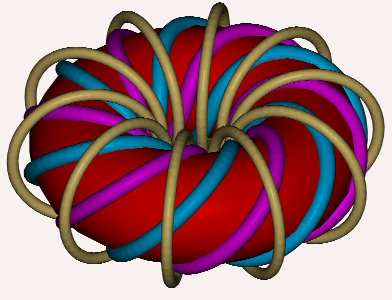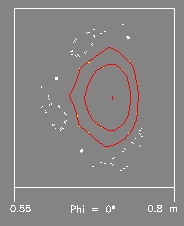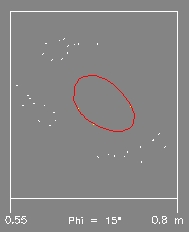Abstract : The simulation of
one particle in a magnetic toroidal field is carried out . The objective is
to know and visualise the magnetic surfaces of a classical stellarator using
a previous code for Monte Carlo simulation of particles. The code is
implemented in Java and improves of one previous code [3]. A classical
stellarator is chosen because it does not contain PF coils.
General description
Although different methods exist to calculate
vacuum magnetic field lines and magnetic surfaces given a set of filamentary
currents, in this case they are calculated using one only particle which
freely evolves inside the torus so to obtain a magnetic surface. The part of
the code that calculate velocity drifts is switched off in order to obtain
the magnetic field lines.
The only objective of
the code is to have a basic tool to know the magnetic field distribution in
a torus. Until a common code used in fusion research-engineering, such as
EFFI code or perhaps IFT code were available, if possible, this code is the
only alternative.
As an engineer focused in fusion engineering issues, a deep knowledge of
plasma behaviour falls out of my intention and possibilities.
The code is named SimPIMF and is implemented in Java to try to take
advantage of the numerous and public mathematical libraries available, like
Colt (CERN libraries) and java.vecMath.
Modelling
The vacuum magnetic field is obtained using MEMCEI v2.1 code
[4].
The model is a classical stellarator with l=2 m=6 that have similar
dimensions to CTH [2], a torsatron in Auburn University. CTH is a l=2 m=5
torsatron. However the classical stellarator modelled here has no any good
mechanical and plasma properties and it is only a first try.
The current used in this calculation is 100kA for each helical coil
and 50kA for each of the 10 toroidal coils. In the Graph 1 the structure of
the coils is shown. The geometrical major radius is 0.75m. The section of
the coils is the section used in MEMCEIv2.1 as the section of the circular
winding. If the section of the winding is rectangular more cylindrical
currents per coil might be necessary to increase precision near and inside
the conductors.
From 1 to 4 Msteeps of 10 picosecondsa and Te=1keV is used to
simulate the particle and the calculations are done following the
explanations in Dolan [1] and are described in [3].
The result obtained when throwing one electron from different points inside
the stellarator are displayed in Graph 2 and 3.
In Graph 1, in white colour, the poloidal section of the
trajectories of an electron on a q=3 magnetic surface is represented. In
yellow (expand the figure), the trajectory for a q slightly higher on an
outer surface. Big magnetic islands have appear for Iota =1/3. In red, two
closed magnetic islands are represented for indeterminate values of q.
SimPIMFv1.0 code cannot calculate values of q since this code only simulate
particles in a basic way.
Graph 3 shows only two magnetic
surfaces at 15º toroidal angle.
Further developments
A code like EFFI might be
useful to test and compare this results and as a better way to do the
same. The knowledge of
dimensions, currents and coils of the mechanically simple CTH stellarator
would be also useful.
References
[1] "Fusion research" T.J. Dolan, Pergamon Press.
[2] "Design and construction progress of the compact toroidal hybrid" Hartwell, G.J., Knowlton, S.F., Watt, C, Hanson, J.D. , Brown, T.
[3] "Development of a basic code for Monte Carlo simulation of trajectories of plasma particles" Vicente M. Queral . See “Past research"
[4] "Magnetic field and forces calculation using MEMCEI v2.1 finite element code. Analysis of the convergence of the solutions" Vicente M. Queral . See “Past research"
Graph 1 . View of the modelled stellarator
Graph 1 . View of the modelled stellarator
Graph 2 . Magnetic surfaces and magnetic islands from the simulation, at toroidal 0º
Graph 3 . Magnetic surfaces and magnetic islands from the simulation, at toroidal 15º
Last Update 19-04-2005


